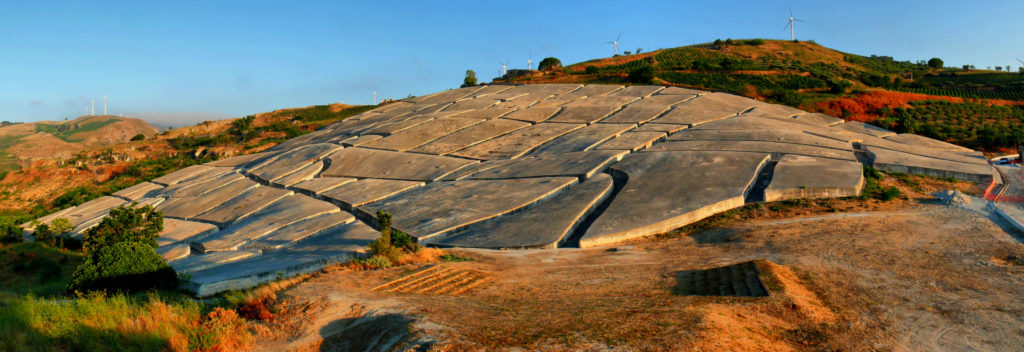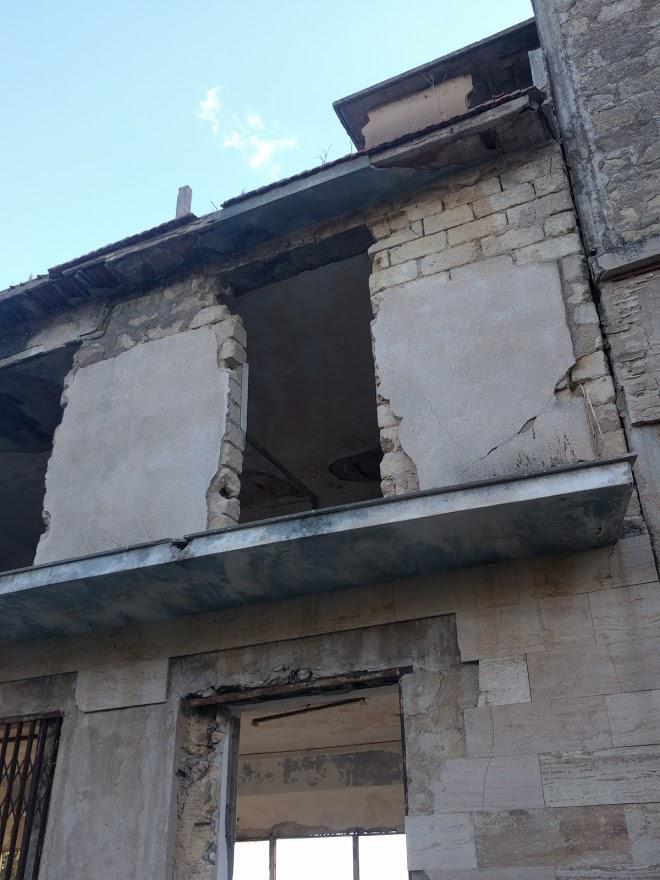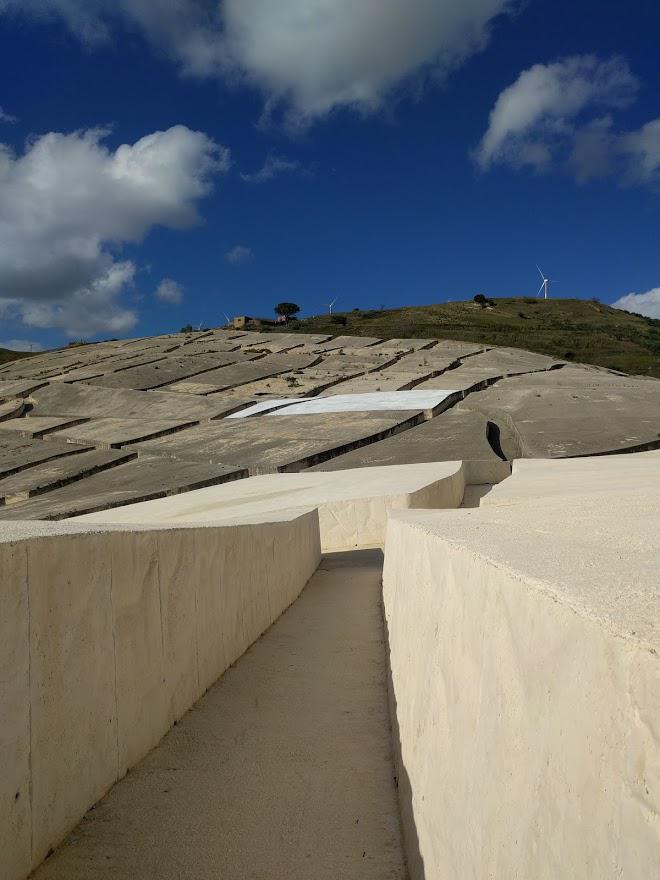
Gibellina Vecchia, Sicily Creto
by Ed Schad
Ovid writes of Sicily situated precariously on top of the body of the god Typhoeus. He’s a giant snake. He “coughs ashes and vomits up fire” from under Mount Etna and tries, from time to time, to “shake off the earth’s weight.” Thus, earthquakes and lava. Ovid goes on to speak of Ceres’s loss of her daughter Proserpina by abduction to the god of the underworld, and her subsequent curse of Sicily as the scene of the crime. Its penalty: erratic rainfall and agricultural blight.
The potential for the land to turn on you, however, is not salient in Sicily. Mostly, you get lonely vectors. You move from lonely point to lonely point across the island’s interior. Your eyes roam the hills and open spaces until they reside briefly on single towns, single houses, or single trees. These bachelors stand alone in the landscape. The brown grasslands and rocky surfaces rise to them as they look out to you. Virgil, in his Georgics, called Sicily, the “Cyclops fields.” This is a hard land, and its hardness may belie its internal turbulence.

Il Creto, a large sculpture by Alberto Burri, does stare out at you when you see it from a distance. The series of forms which make up Il Creto enclose the entire town of Gibellina, Sicily, which was destroyed by an earthquake in 1968 and abandoned. 900 people in Gibellina and in adjacent towns lost their lives, and those who survived the destruction relocated a few kilometers away and rebuilt.
Years later, Burri decided to make a sculpture from the ruined town. When I arrived at the site, I arrived at 3 towns: remnants of the ruined town (Gibellina Vecchia), the sculpture (Il Creto), and, though it is 20 kilometers away, the new town (Nuova Gibellina). There is not much else around. Il Cretto means “the crack.”
The day that I visited Il Creto, midway between Agrigento and Palermo, all the towns were set against a countryside ablaze in fall colors in the mid-day sun, a carpet of nuance and textures. The sculpture looked like a large, blank grid of concrete boxes. Part of it this grid is painted in ivory, the rest in aged, smoky grey. The concrete was tinted slightly pink from the late morning light, and over the course of hours, it brightened white.

It was a nice day. I had a picnic of salami and focaccia, staring out across a blanket of vines, whose crops lend a bite of Mediterranean saline to the taste of wine. Only one other person was present, far down the hill, but the sculpture seemed to be net for whispers. The wind blew through the Sicilian Hills and into the concrete.
I heard voices at Il Creto. Forgive the reference, but the flickering, pulsing murmurs would be best described by sounds found in Star Trek episodes, where people were lost between dimensions or lost their physical state. It was a true city of the dead in the Italo Calvino Invisible Cities sense, and the town seemed to function according to Calvino’s logic.
You, the traveler, come to the three towns and begin trying to come up with a way to tell others what you’ve seen. You see the ruins of old Gibellina and you imagine what it must have been like before the disaster. You imagine other Sicilian towns you’ve seen, full of vibrant people who have fallen on hard times, who sleep in the afternoon, and progress through life much the same way as they have for centuries, as we all have for centuries, loving and fighting, quite content until disaster hits, full of desires and split personalities, competing dreams in our hearts.
And you see the new city on the plain, built from the ruins and populated with survivors after the earthquake, after the random itch of the god under the earth. The city that they built is partially empty, and the spaces that they built for themselves are revealed as only a projection of how they wanted to live rather than as they live. Their modern streets and spare modern houses are decaying and crumbling and covered in graffiti. Many of the stores are shuttered, but there are impromptu markets on the side of the squares, selling cheap plastic kitchen goods and sundries. You imagine that some of these survivors of the dead speak in partial echo of dead, continue to embody their patterns and in a sense live their lives.

But the traveler reserves his most mysterious story for the last city. This city of the dead is a leaden rather than living echo, the reverberation of something that was shouted in a dying breath but only partially heard. It is the whisper inside of tomb on empty nights that are either too cold or too hot or are so perfect that something must be wrong, something must move inside of the contentment. The leaden echo continues to be partially heard, repeatedly, in the hills, until the sound becomes so naturally part of the landscape that most people cease to see the division between the echo and reality. Only the old still hear the echo quietly in the hills.
The traveler will tell you that the echo is the outcome of a lost wish. In the echo, the dead become one with the spaces that they occupied during their lives in fulfillment of the wish. Nothing happens in the echo, but, at times, its forms appear to undulate and flow like a river. From other vantage points, it folds terraced fields inside of its logic and speaks of places where people used to work. It can dissolve into mid-day gold and brown and it can feel like a quarry of chalk or like white cliffs. At its brightest moments in the sun, it can feel like an antechamber to heaven.
Ovid was serious about his god under the ground, how senseless, random, and sudden, tragedy can be. People died at Il Creto. It all still feels very close and warmly human. The lives of the dead, of which I knew nothing, grow out of their memorialized absence, splintering into still more towns. Literary towns, imaginary towns, and mythological towns multiplying
BIO
ED SCHAD is a writer living in Los Angeles. His writing has been included in Art Review, Frieze, Modern Painters, Flash Art, The Brooklyn Rail, The L.A. Weekly, Truthdig, and the Los Angeles Review of Books. In addition, he has contributed essays to mono-graphic catalogs on the art of Liat Yossifor, Robert Irwin, Sterling Ruby, Kaz Oshiro, and many others. For the last 3 years, he has taught writing at Claremont Graduate University.
243 total views , 1 views today
